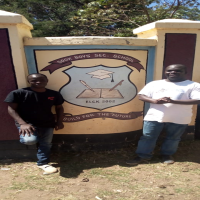
The origin of Long Distance trade.
By the 19th century, there already was trade among Kenyan communities and between Kenya and other countries.
Long distance trade connected the east African interior to the coast in Kenya. Two major commodities (ivory and slaves) were valued at the coast, where they were exchanged for cloth, utensils, ironware and beads.
Until the 1860s, The Akamba served as middlemen between interior and coastal communities. Their trading activities took them from the Mount Kenya region to as far as Baringo and the shores of Lake Victoria. They established good relationship with the local communities through whose territories they passed, though they discouraged other people and communities from participating in the trade. For instance, they spread malicious tales about both the interior and coastal communities.
The communities in east Africa which participated in the long Distance trade in the 19th century. .
• The Akamba,
• Mijikenda,
• Nyamwezi,
• Khartoumers,
• Waswahili,
• Yao,
• Arabs
• Baganda.
The organization of Long Distance trade
• Trade routes to the interior went up to Kilimanjaro, the mount Kenya region and the shores of Lake Victoria. Maasai regions were avoided due to perceived Maasai hostility to strangers.
• Long Distance traders moved into the interior in caravans, using porters, who were either slaves or free men, with goods to and from the East African coast.
• They stopped to rest and replenish food supply at various centers in the interior E.G. Taveta, Mbooni hills, Lake Baringo, Mumias and Buganda.
• From the coast, the traders brought guns, Cotton cloth, beads, glass, swords, Porcelain vessels, bracelets and bangles. From the interior, they got ivory, rhino horns, slaves, hides and skins.
• Long distance trade was financed by the Arabs and Swahili, who employed Akamba and Mijikenda traders. The mode of trade was Barter, although Cowrie shells were introduced as currency in late 19th century.
Edwinnyongesa8 answered the question on April 19, 2018 at 12:09
-
Give reasons why the Akamba exhibited mixed reactions to establishment of colonial rule
(Solved)
Give reasons why the Akamba exhibited mixed reactions to establishment of colonial rule.
Date posted:
April 14, 2018
.
Answers (1)
-
Explain the factors that undermined christian missionary activities in Kenya in 19th century
(Solved)
Explain the factors that undermined christian missionary activities in Kenya in 19th century.
Date posted:
April 14, 2018
.
Answers (1)
-
Give the duties of the Portuguese captains along the coast
(Solved)
Give the duties of the Portuguese captain along the coast.
Date posted:
April 12, 2018
.
Answers (1)
-
State the first prime minister in Kenya
(Solved)
State the first prime minister in Kenya.
Date posted:
April 10, 2018
.
Answers (1)
-
State the functions and roles of a presiding officer
(Solved)
State the functions and roles of a presiding officer
Date posted:
April 10, 2018
.
Answers (1)
-
Explain advantages of modern means of communication
(Solved)
Explain advantages of modern means of communication.
Date posted:
April 9, 2018
.
Answers (1)
-
Explain five social effects of the Uganda railway on Kenya during the colonial period
(Solved)
Explain five social effects of the Uganda railway on Kenya during the colonial period
Date posted:
April 9, 2018
.
Answers (1)
-
Give the main function of the leader of majority in Kenya parliament
(Solved)
Give the main function of the leader of majority in Kenya parliament.
Date posted:
April 6, 2018
.
Answers (1)
-
Explain the development and impact of trans Saharan trade to the communities living in north Africa in the 4th century AD
(Solved)
Explain the development and impact of trans Saharan trade to the communities living in north Africa in the 4th century AD
Date posted:
April 6, 2018
.
Answers (1)
-
Who was the longest serving cabinet secretary in Kenya?
(Solved)
Who was the longest serving cabinet secretary in Kenya?
Date posted:
April 5, 2018
.
Answers (1)
-
Describe the organization of Indian ocean trade by 1900 AD
(Solved)
Describe the organization of Indian ocean trade by 1900 AD.
Date posted:
April 5, 2018
.
Answers (1)
-
What are factors for the rise and downfall of states in pre-colonial Africa?
(Solved)
What are factors for the rise and downfall of states in pre-colonial Africa?
Date posted:
April 3, 2018
.
Answers (1)
-
Discuss the Challenges that missionaries faced in their quest to establish mission stations
(Solved)
Discuss the Challenges that missionaries faced in their quest to establish mission stations.
Date posted:
April 3, 2018
.
Answers (1)
-
Describe seven characteristics of indigenous education.
(Solved)
Describe seven characteristics of indigenous education.
Date posted:
April 1, 2018
.
Answers (1)
-
Assess the role of Kiswahili in promoting national unity in Kenya since independence
(Solved)
Assess the role of Kiswahili in promoting national unity in Kenya since independence.
Date posted:
March 31, 2018
.
Answers (1)
-
Examine the causes and effects of conflicts in Kenya in 2007?
(Solved)
Examine the causes and effects of conflicts in Kenya in 2007?
Date posted:
March 31, 2018
.
Answers (1)
-
Explain the role of harambee philosophy in the development of Kenya?
(Solved)
Explain the role of harambee philosophy in the development of Kenya?
Date posted:
March 31, 2018
.
Answers (1)
-
Which main political event took place in Kenya in 1982?
(Solved)
Which main political event took place in Kenya in 1982?
Date posted:
March 24, 2018
.
Answers (1)
-
Account for the contributions of Seyyid Said for the development of Zanzibar economy (Omani in East Africa)
(Solved)
Account for the contributions of Seyyid Said for the development of Zanzibar economy (Omani in East Africa)
Date posted:
March 24, 2018
.
Answers (1)
-
Why did the Mackay Commission scrap the 'A-Level' component of the education system
(Solved)
Reasons why the Mackay Commission scrap the 'A-Level' component of the education system
Date posted:
March 22, 2018
.
Answers (1)